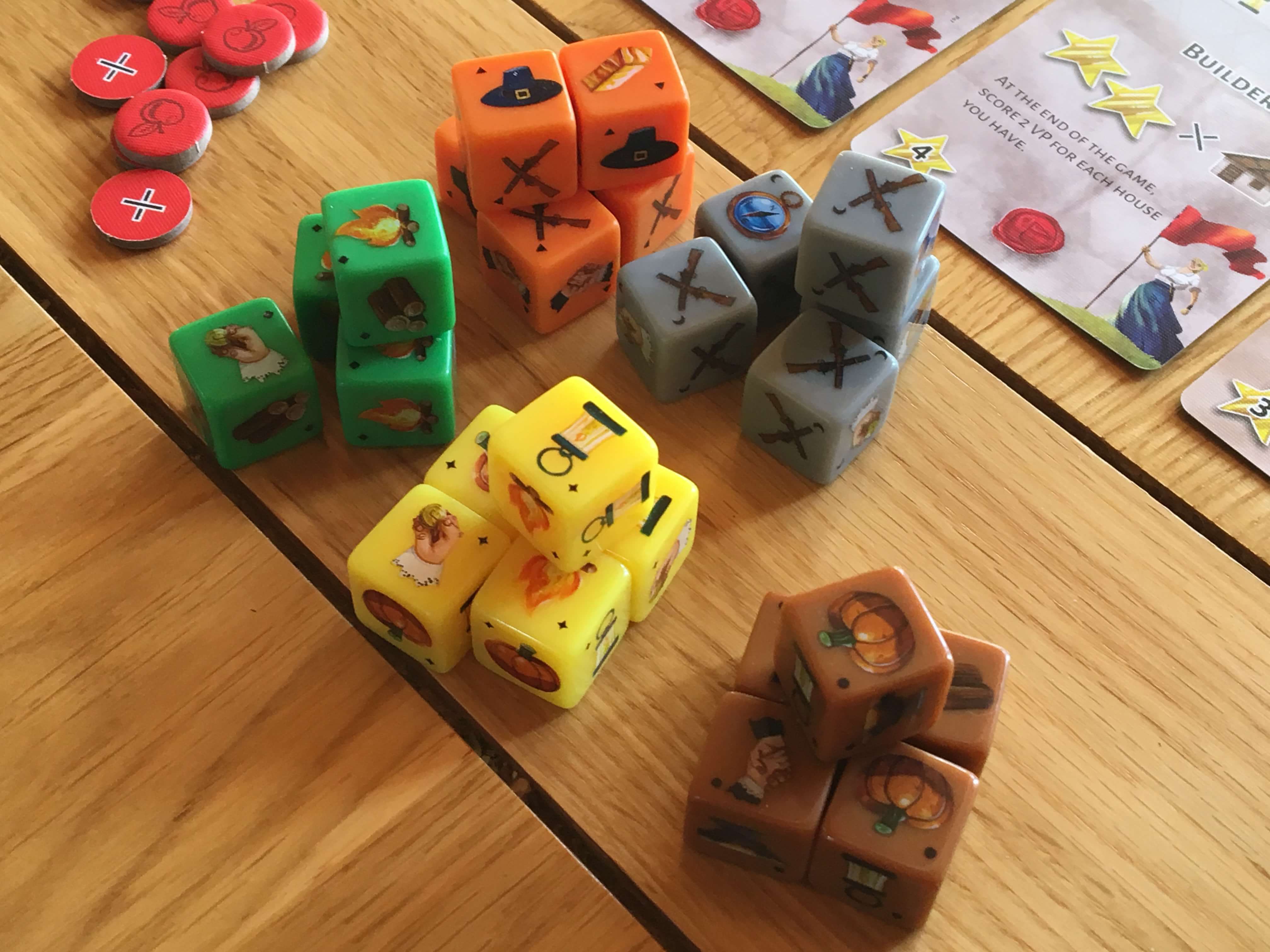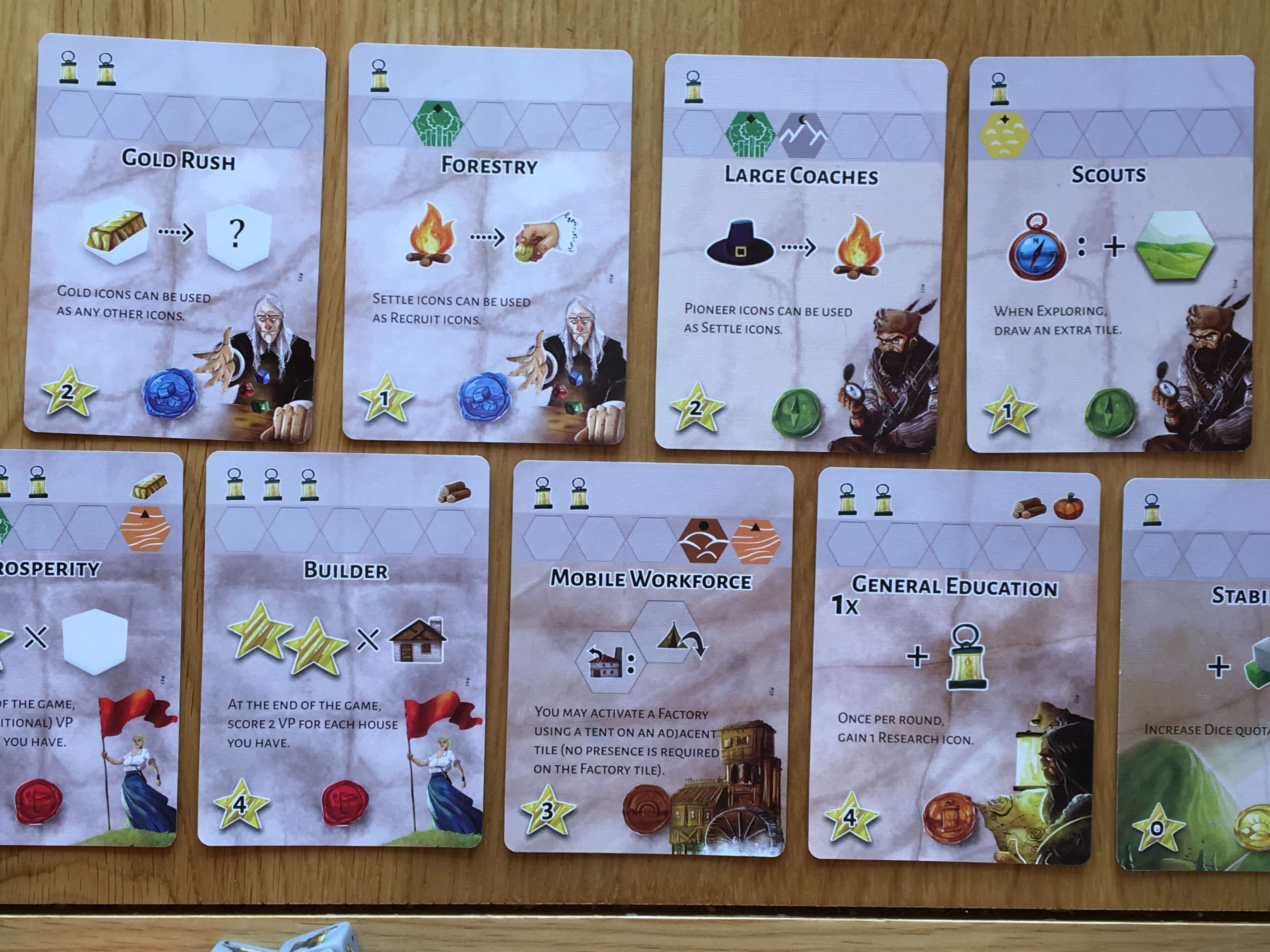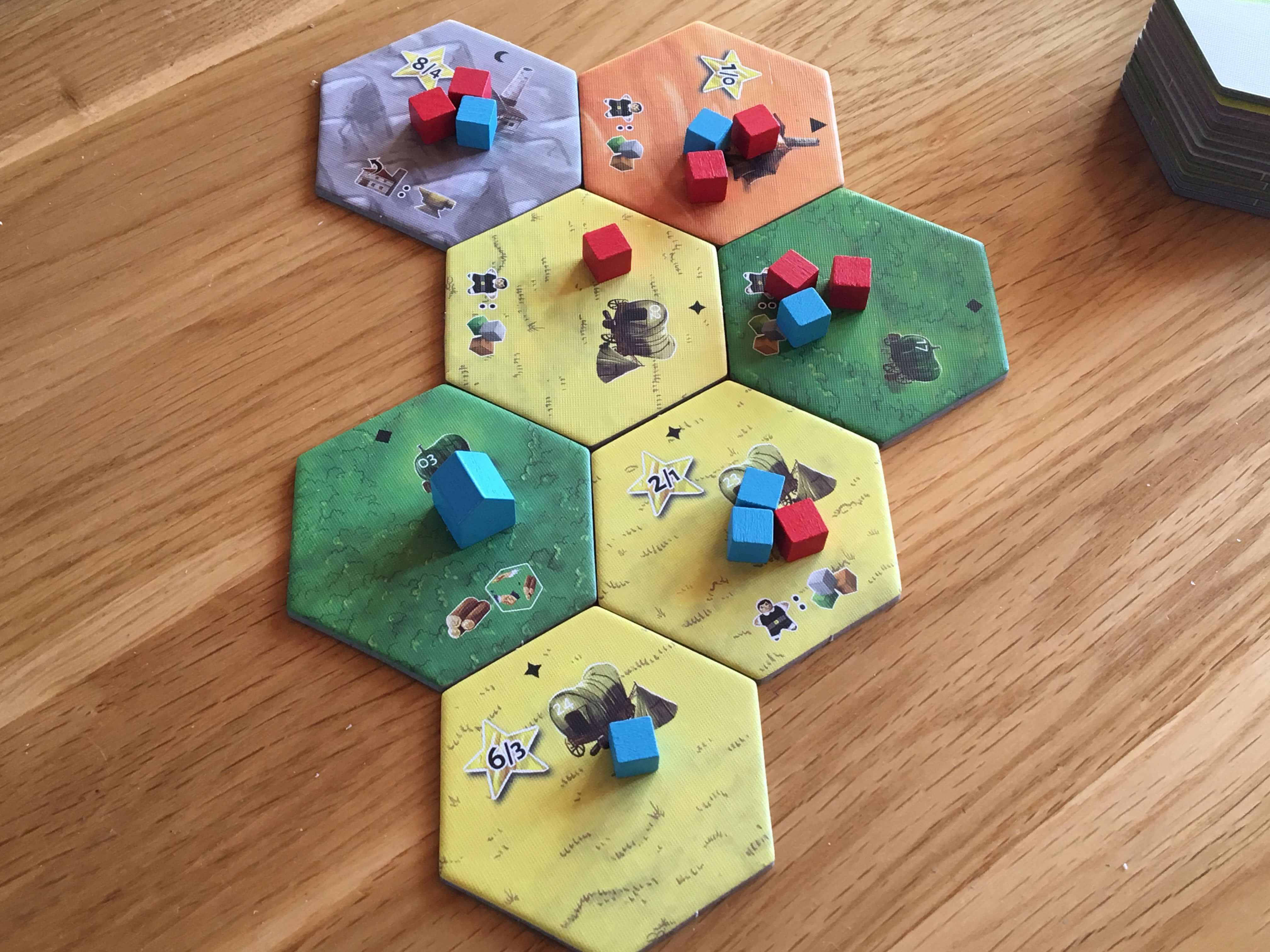Dice Settlers review — Western wonder
Even though the board-game world has seen a fair bit of backlash against colonial themes over the past few months, we do seem to be going through a period where a fair number of games from high profile publishers feature settlers or expanding into new territories. Dice Settlers, from NSKN Games, is one such game, but unlike many of its competitors, this one keeps the theme fairly light, with no conflict with native people or similar. As the title suggests, dice drive the action, but Dice Settlers is far from random. Find out how it plays in our review.
Overview
In Dice Settlers, each player chooses an unnamed band of settlers who are represented in game by cubes and houses of a specific colour, The cubes represent tents, which are used to demonstrate dominance of an area based on whichever player has the most of them in each location — houses represent a permanent settlement and can only be created by converting five tents. The board itself is made up of hexagonal tiles which are built outwards from a central starting point, with the players doing the ‘exploring’ based on the outcome of a dice roll at the beginning of the game.
On that note, everything in Dice Settlers is driven by dice rolls, but there’s a bag-building aspect to it as well. Players can acquire new dice as the result of their exploration, trade, purchases or other interactions with the game, with each dice delivering a different set of possible outcomes depending on its colour. It’s also possible for players to expand the number of dice they draw each turn as well, so the bag building has both quality and quantity elements, each of which must be considered as part of a successful strategy.
The winner of Dice Settlers is the player who scores the most victory points when one of the four endgame triggers is met. These triggers include a player placing all five of their houses; the stack of map tiles or victory points running out; or the supply of dice being depleted to the point where there are only two colours remaining. Players score victory points for control or presence on tiles, for houses placed, technologies claimed and for a handful of other reasons, but Dice Settlers provides you with a score pad to make things more straightforward.
Dice Settlers supports from two to four players when played multiplayer, but it also includes a reasonably comprehensive solo mode that is driven by a number of specific components including a hexagonal action wheel and an action queue track. I’m not going to cover the solo mode in detail in this review, since I’ve spent most of my time playing at two and four players, but I did try the solo mode at two of the different difficulty levels and found it to be quite enjoyable, with a really smart and fast mechanism which has had considerable time and thought invested into it.

Components
Dice Settlers is the first NSKN Games product I’ve encountered, although I was aware of their work by reputation. As it turns out, Dice Settlers is produced to a very high standard, although there are a couple of very minor negatives I’d like to point out, so let’s deal with those first.
My main gripe about how Dice Settlers looks is simply that I wish the cubes were tents. I know, I know, it sounds like nitpicking — and I think it is — but in a game where theme is quite light anyway, I do think that perhaps small wooden triangles or anything that was a bit more evocative would enhance the feeling of building a populace in uncharted territory.
With that one gripe out of the way, more or less everything else in Dice Settlers could be described as very good overall. The board hexes are small but very clear both in terms of the type of terrain they feature (desert, mountain, grassy plains etc.) and the bonus they provide, which might be a resource or a new die, for example. Because the hexes are on the small side, Dice Settlers never takes up the amount of table space you might expect it to, but that’s actually a good thing for playing on a coffee or kitchen table. Unfortunately, where the hexes are small, the player boards are perhaps overly large, although that’s hardly a complaint.
The resource tokens (of which there are plenty) and various other cardboard tokens (as well as the wooden houses) all look great. The real stars of the show are the dice, though, which I guess is what you would hope given the subject matter. There are numerous colours of dice (both basic ones and specific ones to match each resource) and each kind has subtly different printed faces. The main thing is that each die and every die face is clear and distinct, aiding in the speedy assessment of what you’ve rolled. It also helps that these are the kind of large, satisfying-to-roll dice that feel great to pull out of the bag and chuck around.
There are a couple of other components in Dice Settlers to consider. The deck of Technology cards is one of them and the instruction manual is probably the other, aside from the solo components and a few other odds and ends. Mechanically, the Technology cards are an interesting addition to Dice Settlers which I’ll explain in more detail later, but at a component level, the main thing is how clearly laid out they are. The cost of a technology, its benefit and how many points it is worth are clear as day. The cards do feature artwork, but it is very much secondary to the functional elements, which, if anything, is my preference. The manual is clear and detailed, with a nice layout and a lot of examples that articulate different possible outcomes. I learned more or less everything I needed to know about Dice Settlers in just over an hour and it’s fairly simple to grasp, largely thanks to the clarity the manual provides.

Turn Structure
In Dice Settlers, players work their way through a series of rounds, each of which begins with a rolling phase. The players simultaneously draw dice equal to their quota (which is three to begin with),then roll them. Pioneer faces give players the option to set one die or re-roll up to three of them. They may instead spend any resource token to set a die or draw two additional ones and roll them, effectively increasing their dice pool. This feels a tiny bit fiddly at first and it’s hard to commit the different tweaks that pioneer faces and resource tokens are each capable of to memory, but you’ll snag it within one it two games.
After they draw dice, players each take one action, in turn order. There is another round of actions after this, with anyone unable to take an action simply passing. Some circumstances allow a third action, but in all circumstances, a player may only take each specific action once. For example, if a player explores on their first action, they may not do so again until the next turn. The actions players can take are absolutely linked to the dice faces they have rolled and the more matching dice used to perform an action, the more effective or powerful it will be.
In terms of what those actions are, there’s Explore, which allows the player to draw hex tiles up to the number of dice spent, then choose one and place it adjacent to a tile on which they already have a presence. When they place a tile like this, they add one of their tent tokens from the general supply, whilst any adjacent player may add a tent from their personal supply. If anyone does so, the player taking the Explore action can place a second tent, but again it must come from their personal supply — in this way, a player who Explores can always take control of the tile they place.
The next action is Recruit, which basically just lets players add dice to their bag. One, three or six recruit faces can be swapped for one, two or three dice. Players may choose dice of any colour from the hexes they have a presence on. Then, there is the Settle action, where players can take tents from the general supply to add their personal supply, or from their personal supply to add to the board. Each symbol spent results in being able to move one tent, basically. Raiding is similar to settling, but for each symbol spent, you may remove an opponent’s tent and replace it with one from your personal supply.
When it comes to resources, there are two actions available to players, which are Harvest and Trade. For the Harvest action, players simply total up the resource symbols on their dice and take a resource token for each matching face. For example, if you roll two wood faces, you take two wood resources. Trade, on the other hand, allows players to trade in different combinations of resources and dice to obtain victory points, with more points awarded for larger numbers of resources or dice of the same kind.
The final action is Research, which lets players spend a number of lamp symbols to place a tent on one of the Research cards — these usually confer benefits like a higher dice quota or similar. The game actually makes recommendations about different sets of technology cards to play with (including the starting set, which is what I’ve shown in the pictures). Whilst understated, technology has a huge impact on the outcome of Dice Settlers and must not be underestimated. After all players have taken one, two or occasionally more actions, you all perform cleanup phase wherein you check endgame conditions, move dice to the spent pile and so on ahead of the next turn.

Game Experience
When I began playing Dice Settlers, I felt as if it would turn out to be a little underwhelming. I’ve already mentioned that I’m not a huge fan of the cube tents, but over and above that, I wouldn’t say that the theme is overwhelmingly strong here. Yes, you will explore new locations and expand your footprint, but there’s no real peril in doing so — only good things can happen. I was surprised to find that Dice Settlers doesn’t feature an event or peril deck with more thematic elements, for example.
With that said, the more I played Dice Settlers, the more the mechanical side of the game began to shine through in its own right. Mainly, I noticed this in how well balanced Dice Settlers is, regardless of which way you choose to pursue victory. The main ways to win include generating resources and trading them, expanding aggressively (and raiding others) or focusing on technology and using what’s available to enhance other strategies as appropriate. Raiding is as outwardly aggressive as it sounds, but it’s not as overpowered as it might be — a player can only raid if they have a tent in their personal supply to add to the board, so anyone who follows that path will need to build up both grey and white dice to maintain a plentiful supply of both firepower and tents.
Whilst there is no defence against raiding, players can build up to five tents and convert them into a house. Houses, unlike tents, cannot be raided or removed for any reason, which is a further legitimate strategy to use against raiders. Because trading is always more efficient when it comes to scoring victory points, retaining a small footprint (just large enough to get the two or three different kinds of dice you need), then focussing on generating dice (and in turn resource tokens) of one type can also score a lot of points. Since resources also allow the manipulation of dice, this approach can open up some other options.
All in all, playing Dice Settlers is an interesting and challenging experience and it plays quite differently (but no worse) with different player counts. Two-player and solo games are similar to each other in that the board stays quite tight, whilst at four players it can become quite expansive. Depending on which hex tiles come out, the player count can result in contested areas, or alternatively really powerful tiles can end up in locations where only one player will have a realistic chance of occupying them. In all of these different scenarios, Dice Settlers is a fun and interesting experience that is simple to pick up and reasonably thinky, although I wouldn’t say it’s difficult to master like some heavier games are.

Conclusion
Like most games, Dice Settlers isn’t perfect, but it does a lot of things well and it delivers a consistent, balanced experience without feeling as if it pushes players into a specific, obvious strategy. Instead, it intuitively allows players to define their own strategy based (perhaps) on early rolls or hex tiles, or by assessing which technology cards are available. None of the scoring information is hidden or randomised in Dice Settlers, so players are free to zero in on any strategy they like, right from the outset. This is a good and a bad thing, since it does slightly disadvantage new players, I’d say.
The artwork and theme are very light in Dice Settlers and I think it could just as easily have been set in space, or more or less anywhere else. It is, essentially, a 4X (explore, expand, exploit and exterminate) game, yet it doesn’t feel like one at all. This lightness of theme makes Dice Settlers feel welcoming, as does how accessible it is to play. Yes, there are some fiddly scoring rules and other things to consider that make it more complex than a gameplay game, but Dice Settlers isn’t much more challenging to learn than something like Catan, for example.
Ultimately, if you’re looking for theme, you’re in the wrong place with Dice Settlers. If you’re after something that plays in about an hour, offers a fast setup and an easy teach, you might be interested. If that’s enough to entice you to consider Dice Settlers, then what will make you make it a long term fixture in your collection will be the consistent, mid-weight gameplay. Finding games with such broad, 4X gameplay that play as fast and as easily as Dice Settlers does is rare — and for that, I applaud it.
A copy of Dice Settlers was provided for review purposes. You can find out more about it on the website of publisher NSKN Games.

Comments are closed.